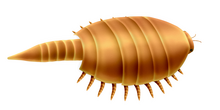Apankura
| Apankura Temporal range:
| |
|---|---|

| |
| Reconstruction of A. machu | |
| Scientific classification | |
| Domain: | Eukaryota |
| Kingdom: | Animalia |
| Phylum: | Arthropoda |
| Subclass: | †Euthycarcinoidea |
| Genus: | †Apankura Vaccari et al., 2004 |
| Species: | †A. machu
|
| Binomial name | |
| †Apankura machu Vaccari et al., 2004
| |
Apankura machu is a Cambrian euthycarcinoid from the Santa Rosita Formation of Argentina.[1] It was at one point the only Cambrian euthycarcinoid. However, Mosineia and Mictomerus are likely older.[2]
Description
[edit]Apankura is roughly 4 cm long, and has large mandibles, a trait previously unknown from euthycarcinoids. The antennae are uniramous like other euthycarcinoids, with a possible buccal complex present behind the mandibles. No post-mandibular oral appendages are present. The pre-abdomen is composed of five tergites, with 11 uniramous limb pairs, with the tergites showing "segment decoupling" where there are more limbs than tergites. The pre-abdomen also has 11 sternites, each roughly 3 times wider than long. The pre-abdominal limbs match other euthycarcinoids, although they taper distally and lack setae. The apodemes are preserved as several dark rods. The post-abdomen is incomplete but composed of at least six segments, all lacking limbs, with the gut preserved as a dark line in the centre. A circular structure on the second post-abdominal segment is of unclear function, although it may be a gonopore. Apankura is unique among euthycarcinoids due to the reduced anterior pre-abdominal limbs, a longer post-abdomen and relatively few limb podomeres.[1]
Etymology
[edit]Apankura derives from a Quechua word meaning "crab", whilst machu derives from a word meaning "grandfather" in reference to the age of the fossils.[1]
References
[edit]- ^ a b c Vaccari, N. E.; Edgecombe, G. D.; Escudero, C. (July 2004). "Cambrian origins and affinities of an enigmatic fossil group of arthropods". Nature. 430 (6999): 554–557. doi:10.1038/nature02705.
- ^ Collette, Joseph H.; Hagadorn, James W. (July 2010). "Three-dimensionally preserved arthropods from Cambrian Lagerstätten of Quebec and Wisconsin". Journal of Paleontology. 84 (4): 646–667. doi:10.1666/09-075.1.
